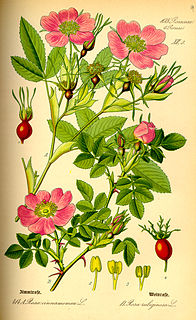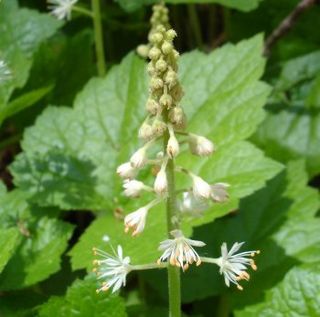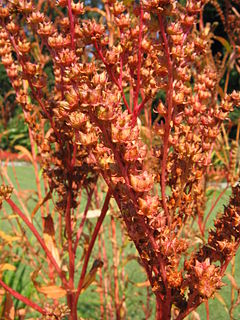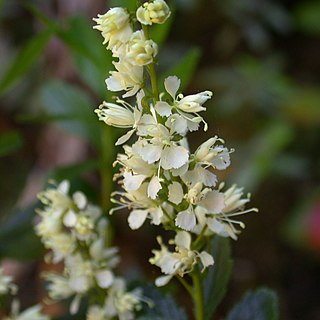
Rosales is an order of flowering plants. It is sister to a clade consisting of Fagales and Cucurbitales. It contains about 7,700 species, distributed into about 260 genera. Rosales comprise nine families, the type family being the rose family, Rosaceae. The largest of these families are Rosaceae (90/2500) and Urticaceae (54/2600). The order Rosales is divided into three clades that have never been assigned a taxonomic rank. The basal clade consists of the family Rosaceae; another clade consists of four families, including Rhamnaceae; and the third clade consists of the four urticalean families.

Rosaceae, the rose family, is a medium-sized family of flowering plants that includes 4,828 known species in 91 genera.

The Saxifragales (saxifrages) are an order of flowering plants (Angiosperms). They are an extremely diverse group of plants which include trees, shrubs, perennial herbs, succulent and aquatic plants. The degree of diversity in terms of vegetative and floral features makes it difficult to define common features that unify the order.

Saxifragaceae is a family of herbaceous perennial flowering plants, within the core eudicot order Saxifragales. The taxonomy of the family has been greatly revised and the scope much reduced in the era of molecular phylogenetic analysis. The family is divided into ten clades, with about 640 known species in about 35 accepted genera. About half of these consist of a single species, but about 400 of the species are in the type genus Saxifraga. The family is predominantly distributed in the northern hemisphere, but also in the Andes in South America.

Saxifraga is the largest genus in the family Saxifragaceae, containing about 465 species of holarctic perennial plants, known as saxifrages or rockfoils. The Latin word saxifraga means literally "stone-breaker", from Latin saxum + frangere. It is usually thought to indicate a medicinal use for treatment of urinary calculi, rather than breaking rocks apart.

The rosids are members of a large clade of flowering plants, containing about 70,000 species, more than a quarter of all angiosperms.

Physocarpus, commonly called ninebark, is a genus of flowering plants in the family Rosaceae, native to North America and northeastern Asia.

Tolmiea menziesii is a species of flowering plant in the family Saxifragaceae. It is known by the common names youth on age, pick-a-back-plant, piggyback plant, and thousand mothers. It is a perennial plant native to the West Coast of North America, occurring in northern California, Oregon, Washington, British Columbia and southern Alaska. It occurs as a naturalised plant or garden escape in Scotland, parts of Wales, Northern Ireland and northern and western parts of England.

The basal angiosperms are the flowering plants which diverged from the lineage leading to most flowering plants. In particular, the most basal angiosperms were called the ANITA grade, which is made up of Amborella, Nymphaeales and Austrobaileyales.

Penthorum is a genus of plants in the order Saxifragales. They are erect herbaceous perennials about half a meter tall. The genus consists of two species, one from east Asia and one from eastern North America. It is variously classified in the family Saxifragaceae or its own family Penthoraceae. Its closest relatives may be in Haloragaceae.
Lepuropetalon is a genus of flowering plants in the family Celastraceae. Before it was placed in the family when it was defined by the Angiosperm Phylogeny Group's APG III system in 2009, it had been placed with Parnassia in the family Parnassiaceae, now usually treated as a segregate of Celastraceae. When their most recent revision of Angiosperm classification was published in 2016, it retained its position in the family Celastraceae. Lepuropetalon has only one species, Lepuropetalon spathulatum. It is a winter annual that is most abundant in eastern Texas and western Louisiana. From there, it occurs sporadically southward into Mexico, and eastward through the Atlantic and Gulf coastal plain, and rarely in the Piedmont Plateau, to North Carolina. It has a disjunct distribution. In addition to the area mentioned above, it is also found in Uruguay and central Chile.

Tetracarpaea is the only genus in the flowering plant family Tetracarpaeaceae. Some taxonomists place it in the family Haloragaceae sensu lato, expanding that family from its traditional circumscription to include Penthorum and Tetracarpaea, and sometimes Aphanopetalum as well.

Hydrostachys is a genus of about 22 species of flowering plants native to Madagascar and southern and central Africa. It is the only genus in the family Hydrostachyaceae. All species of Hydrostachys are aquatic, growing on rocks in fast-moving water. They have tuberous roots, usually pinnately compound leaves, and highly reduced flowers on dense spikes.
Pamela Soltis is an American botanist. She is a distinguished professor at the University of Florida, curator at the Florida Museum of Natural History, principal investigator of the Laboratory of Molecular Systematics and Evolutionary Genetics at the Florida Museum of Natural History, and founding director of the University of Florida Biodiversity Institute.
Douglas Soltis is a Distinguished Professor in the Laboratory of Molecular Systematics & Evolutionary Genetics, Florida Museum of Natural History and Department of Biology at the University of Florida. His research interests are in plant evolution and phylogeny, an area in which he has published extensively together with his wife Pamela Soltis and together they were the joint awardees of the 2006 Asa Gray Award. They are the principal investigators in the Soltis laboratory, where they both hold the rank of Distinguished Professor and are contributing authors of the Angiosperm Phylogeny Group.

Macarthuriaceae is a family of plants in the order Caryophyllales and consists of a single genus, Macarthuria.
Conimitella is a genus of flowering plants belonging to the family Saxifragaceae.

Elmera is a monotypic genus of flowering plants belonging to the family Saxifragaceae. It contains one species, Elmera racemosa(S.Watson) Rydb..
Saxifraga svalbardensis is a species of flowering plant in the family Saxifragaceae, endemic to Svalbard. It arose, probably after the end of the last ice age, as a hybrid between Saxifraga rivularis and S. cernua.














